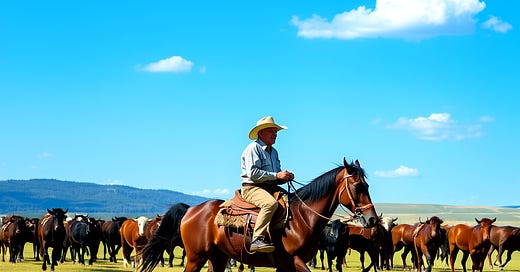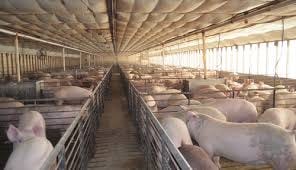Well the 2022 USDA Ag Census has been released and it is ugly for the future of the USA and its farmers and ranchers.
You can find it here: https://www.nass.usda.gov/AgCensus/
Cattle numbers are falling precipitately on farms of less than 500 cattle. Eventually this will lead to just a few big growers and prices will go up as competition will be sparse.
The average age of farmers has increased to 58.1 years old from 57.5 years old in 2017.
2022 2017
5 to 34 years ......................................................................239,480 234,496
35 to 44 years ......................................................................426,616 390,345
45 to 54 years ......................................................................519,430 614,654
55 to 64 years ......................................................................837,520 955,354
65 to 74 years ......................................................................826,931 757,936
75 years and over ................................................................467,062 396,106
These number should scare the hell out of us. Over 2.1 million farmers are over age 55. 22,100 more than in 2017. The last number is simply mind blowing. We have 467,062 farmers over 75! Let’s be brutally honest here. How many 75 year olds do you know that could still climb onto these big machines, or a
horse and go all day? Even 65 year olds? Many people that old are in a home, need day care or simply cannot navigate all that well.
This chart is equally devastating.
WE have 296, 480 classified as young producers. Of that 61,382 are full time, the rest have off farm jobs. That means they work a 8 hour day and then farm when they get home. I’ve done this since I was 18 and I can tell you it is not for everyone.
So we have 296,480 young producers and 467,062 producers over age 75. How long are these 75 + year olds going to be farming or even living in the next 5 years? We are nowhere close to replacing them and then when you look at the 65 to 75 it does not take a genius to figure out we are looking at a huge problem in the next 10 years or so.
A look at beef producers. Look at the 1-99 columns. These are small producers, they produce over 1/3 of the beef cattle in the USA. These producers have a target on them from the government and big AG. They want us gone. Their most recent attempt is RFID tags. While they run around $3.00 each that does not include rounding cattle up, putting them through the chutes and the labor to do so. This is not a one person operation. Many if not nearly all the less than the 1-9 cattle people have no headgate and their chute facility consists of maybe a shed with gates. This is NOT safe to install these tags. You must have a head gate and chute system that will hold these cattle. This can range from around $500.00 just for the head gate and then associated panels to over $5000.00 for a head gate and squeeze chute and associated panels. All this for a tag? People just are not going to do that. Its not like profits are humongous and these small cattlemen and women have all this extra money laying around. The 1-19 cattle people will quit, they already take a huge hit at the auction barn selling their cattle and this is just ging to be the end of the fight for them. A lot of us in the 25-50 range will leave also. I’m just not going to let a bunch of control freak fools tell me what to do. I’m not spending that kind of time and money so the big 4 packers can hose cattlemen and women and blame us for their filthy plant operations.
Now a quick look at hogs:
This consolidation never works out for consumers in the end. It also is going to limit genetics. Berkshire, Chester White, Duroc, Hampshire, Landrace, and American Yorkshire are the breeds used in commercial operations. Meanwhile their are 600-750 breeds world-wide.
https://breeds.okstate.edu/swine/ list of animals breeds in the USA.
Genetics has a lot do with disease susceptibility to disease, flavor, disposition, size etc… we need to preserve these other breeds genetics in case a disease specific to these 8 major breeds come along and devastates the hog herd.
Those raising less than 500 could be wiped out today and it would hardly be a blip. Less than 750,000 out of 73 million, that is just over 1%. of the hogs raised. So the raising of hogs is known by very few farmers at this point. That can be a huge problem in the not too distant future.
https://www.r-calfusa.com/weekly-address-going-going-soon-gone/
We’ve lost another 107,000 independent beef cattle farmers and ranches in just the past five years! That’s a loss of over 21,000 cattle producers per year during the past five years. And, we’ve lost another 2.5 million mother cows, representing an 8% reduction of our nation’s mother cow herd in five years, with a loss rate of half a million mother cows per year.
That’s 57 per day! Why? well were are getting old and the younger generation simply cannot easily get into this business. It take millions of investment dollars and the profits swing wildly. I know people thought a couple of years ago - even in ag journals/magazine they were talking about high cattle prices. At that time we were in a drought here ( still are) and pastures were done in July and hay needed to be fed. Hay was going for $300-$400 for a ton IF you could find it.
The other thing that is not talked about is the knowledge that is dying with these old farmers and ranchers. I can say I am learning something new all the time, and fortunately my son is gaining that knowledge also. But what would and will happen to this knowledge if future generations are not taking up the profession? It takes a lifetime to build this knowledge and its about to disappear. This disappearing of knowledge is going to be the most devastating. How many of use can raise food in sufficient quantity to feed our family let alone raise meat and eggs? I have covered several lost arts in previous stacks. From making tallow and yogurt to raising chickens. Canning is another lost art. My mom and grandmother canned every fall, today the vast majority of us have no idea how to can or preserve food. It is very possible this knowledge will be require in the future and it is slowly being lost.
Solutions:
First and foremost get the government out of agriculture. The more the government has gotten involved the more farmers we have quitting. This consolidation is going to result in higher prices sooner rather than later. Its a captive market - monopoly.
Break up the big 4. These packers are keeping small butcher plants from getting started. These big 4 lobby the government for all sorts of rules ( RFID tags), meat inspection, off farm sales etc… For the good of our food supply we need smaller plants dotted across the country. Right now if one of these plants closes it can mean a huge hit on cattle prices and supplies to stores. Leading to higher store prices for consumers but devastating price cuts for producers.
Let farmers sell their products intra state without all the federal red tape. I should be able to sell my products without federal interference in my home state.
The under 100 head producers are effectively kept out of the big 4 contracts for cattle. WE are left with auction barns and that results in lower prices. For years hog producers signed contracts with packers on their hogs. In that time the hog industry has been devastated with over 90% of hog farms gone in the last 40 years. We are well on our way in the cattle industry.
We are witnessing how this is going to work right now. Chickens have been controlled by big ag for 50+ years. The farmers are nothing but share croppers that are kept on a short leash, work their tails off and get little to show for it. All the risk is put on them by Cargill, Pilgrims Pride, Perdue and Tyson.
https://www.zippia.com/advice/largest-poultry-companies/
The largest poultry company in the U.S. is Cargill Meat Solutions, with $165 billion in sales and a market share of 22%.
The link above cover the top 10 poultry producers. With Cargill the largest at 22% the rest pretty much control the rest of the market.
Then when we look at the egg situation with the consolidation we are seeing how horrible this can be for consumers. Sickness wipes out huge numbers all at once, vs a large number of small farms that do not get wiped out en masse.
Most of all we should by our food as much as we can from a local farmer. This helps them raise their families, it provides us with a superior product and maybe it will encourage that farmers children to stay on the farm and provide food for future generations and preserve the all critical knowledge base.
Cal-Maine – the only major publicly held egg producer, with brands including Land O’ Lakes and Egg-Land’s Best – kept its production stable at approximately 1.1 billion dozen eggs a year from 2021 to 2024, according to the farmer-led nonprofit’s analysis.
Then we have this lunacy.
Farm Action, a group backed by smaller farmers to take aim at “corporate monopolies,” claims that leading egg producers are keeping the supply of new egg-laying hens “stagnant” in order to prolong their two year run of record profits.
Does this make any sense? A group representing small farmers is complaining that CAl- Maine is not expanding? HUH? They want Cal-Maine to get bigger?
For instance, I just changed my chicken feed to a soy free product as their is a certain segment of the population that is allergic to eggs in which the chicken is fed soy. I do not have enough eggs to serve this market and am expanding my flock to meet that need. In my research I have found that soy is starting to be looked at and it possibly is not healthy for chickens or US. While the taste difference is subtle it is present.
We have some serious problems in our food chain that need to be addressed. We have far more control over this than we think. Buying from a local farmer stops this increased concentration in the food supplier space. It give hope to the younger generation that they could make a life farming. The choice is ours - sustainable small ag or being controlled by big ag. Big ag will put what ever they want in your food and call it necessary and healthy - like red dye #3 that has finally been banned. Small farmers will change their animal programs to meet needs of consumers.










RFK says he will be addressing this. Also, I think the anti-meat bias has played into this shortage. Finally, the EPA caused many problems but now their power is in the process of being reduced.